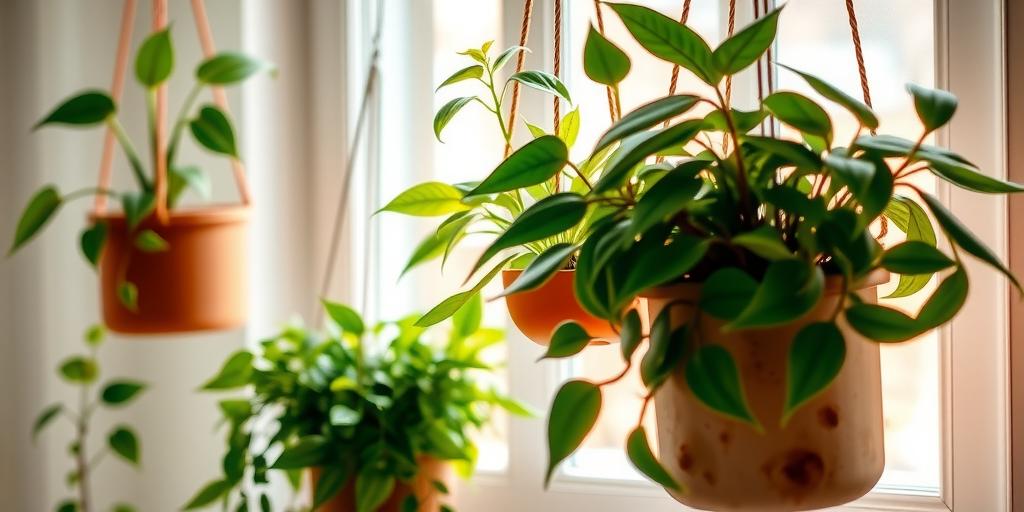
5 Easiest Hanging Plants to Grow in Low Light (2025)
Looking for low-light hanging plants that thrive indoors? Discover the 5 easiest hanging plants to grow in low light, perfect for beginners and busy plant lovers!
Introduction
Do you love the look of lush, trailing plants but worry your home doesn’t get enough sunlight? Good news—you don’t need a bright, sunny space to enjoy beautiful hanging plants! Many low-maintenance varieties thrive in dim corners, making them perfect for apartments, offices, or rooms with limited natural light. In fact, studies show that indoor plants can boost mood and purify the air—so why not add some greenery to your space? Here are the 5 easiest hanging plants to grow in low light, along with care tips to keep them thriving!
Pothos (Epipremnum aureum)
Pothos is one of the most forgiving and adaptable houseplants, making it a top choice for low-light environments. Whether your space has minimal natural light or just a dim corner, this plant will thrive without much fuss. Its heart-shaped leaves come in various shades, from deep green to variegated gold and white, adding a touch of life to any room.
Why It’s Great for Low Light
Pothos can survive in almost any lighting condition, including dimly lit rooms. While it grows faster in bright, indirect light, it won’t wither away in low light—it just grows a bit slower. This adaptability makes it perfect for offices, bathrooms, or any space that doesn’t get much sunlight.
Care Tips
-
Watering: Let the soil dry out between waterings. Overwatering is the biggest threat to pothos, so when in doubt, wait a few more days before watering.
-
Light: While it tolerates low light, it will grow more vigorously with moderate indirect light.
-
Maintenance: Trim long vines to encourage bushier growth, or let them trail for a cascading effect.
Best Varieties
-
Golden Pothos: Classic green leaves with golden-yellow variegation.
-
Marble Queen: Creamy white and green marbled foliage.
-
Neon Pothos: Bright, lime-green leaves that add a pop of color.
Bonus
Pothos is an excellent air purifier, helping to remove toxins like formaldehyde and benzene from indoor air.
Spider Plant (Chlorophytum comosum)
If you’re looking for a low-light plant that’s both easy to care for and fun to propagate, the spider plant is a fantastic choice. Known for its arching leaves and tiny “spiderettes” that dangle from the mother plant, it’s a great option for hanging baskets or shelves.
Why It’s Great for Low Light
Spider plants thrive in bright, indirect light but can also adapt to lower-light conditions. They won’t grow as quickly in dim areas, but they’ll still stay healthy and produce their signature baby plants.
Care Tips
-
Watering: Keep the soil slightly moist but not soggy. Spider plants prefer well-draining pots to prevent root rot.
-
Light: While they tolerate low light, they do best in medium indirect light.
-
Propagation: Simply snip off the spiderettes and root them in water or soil—they’re incredibly easy to multiply!
Best Varieties
-
Variegated: Green leaves with white stripes.
-
Bonnie: Curly, twisted foliage for a unique look.
-
Green: Solid green leaves (less common but just as hardy).
Bonus
Spider plants are non-toxic to pets, making them a safe choice for homes with cats and dogs.
Heartleaf Philodendron (Philodendron hederaceum)
With its lush, trailing vines and heart-shaped leaves, the heartleaf philodendron is a favorite among plant lovers. It’s especially great for low-light spaces, where it can still grow long, beautiful vines without much effort.
Why It’s Great for Low Light
This plant naturally grows under the canopy of trees in the wild, so it’s well-adapted to shady conditions. While it prefers bright, indirect light, it won’t suffer in dimmer spots—it just grows a bit slower.
Care Tips
-
Watering: Water when the top inch of soil feels dry. It’s drought-tolerant, so occasional neglect won’t harm it.
-
Light: Can survive in low light but thrives in medium indirect light.
-
Pruning: Trim back leggy vines to encourage fuller growth.
Best Varieties
-
Brasil: Green leaves with yellow streaks.
-
Micans: Velvety, deep green leaves with a reddish underside.
-
Lemon Lime: Bright, chartreuse foliage for a vibrant look.
Bonus
Heartleaf philodendrons are fast-growing and require minimal care, making them ideal for beginners.
English Ivy (Hedera helix)
English ivy is a classic trailing plant that adds a touch of elegance to any space. Its ability to thrive in low light makes it a great choice for darker rooms, and its cascading vines look stunning in hanging planters or on shelves.
Why It’s Great for Low Light
This plant naturally grows in shaded forest areas, so it’s well-suited for indoor spaces with indirect or low light. It won’t grow as vigorously as it would in bright light, but it will still maintain its lush appearance.
Care Tips
-
Watering: Keep the soil consistently moist but not waterlogged.
-
Humidity: Mist occasionally or place near a humidifier, as ivy enjoys higher humidity.
-
Light: Prefers bright, indirect light but adapts well to low-light conditions.
Best Varieties
-
Glacier: Silver-variegated leaves with white edges.
-
Goldchild: Green leaves with golden-yellow margins.
-
Needlepoint: Delicate, pointed leaves for a refined look.
Bonus
English ivy is known for its air-purifying qualities, helping to reduce indoor pollutants like mold and formaldehyde.
ZZ Plant (Zamioculcas zamiifolia)
If you’re notorious for forgetting to water your plants, the ZZ plant is your best friend. This hardy plant thrives on neglect and can survive in some of the darkest corners of your home.
Why It’s Great for Low Light
The ZZ plant is nearly indestructible, thanks to its rhizomes that store water. It can survive in extremely low light, making it perfect for windowless offices or dim hallways.
Care Tips
-
Watering: Water sparingly—once every 2-3 weeks is usually enough. Overwatering is its only real enemy.
-
Light: Tolerates low light but can also handle brighter spots.
-
Maintenance: Wipe the leaves occasionally to keep them dust-free and shiny.
Best Varieties
-
Raven: Striking dark purple-black foliage.
-
Regular Green: Glossy, deep green leaves.
Bonus
The ZZ plant is practically foolproof—ideal for beginners or anyone who tends to forget about their plants.
Each of these plants offers unique benefits for low-light spaces, whether you’re looking for air purification, easy propagation, or just a resilient green companion. Pick the one that fits your style and enjoy the greenery without the stress!
Conclusion
Adding hanging plants to your home doesn’t have to be hard—even if you don’t have perfect lighting! These 5 easy low-light hanging plants are resilient, beautiful, and perfect for beginners. Whether you choose a trailing Pothos or a hardy ZZ Plant, you’ll enjoy lush greenery without the hassle. Ready to transform your space? Pick your favorite and start growing today!
